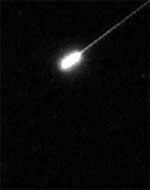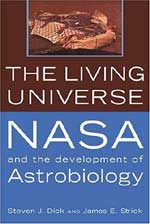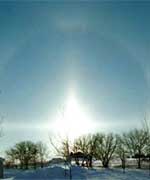
Image credit: George Varros
Monday, December 13 – Tonight will be one of the most hauntingly beautiful and most mysterious displays of celestial fireworks all year – the Geminid meteor shower. First noted in 1862 by Robert P. Greg in England, and B. V. Marsh and Prof. Alex C. Twining of the United States in independent studies, the annual appearance Geminid stream was weak, producing no more than a few per hour, but it has grown in intensity during the last century and a half. By 1877 astronomers were realizing a new annual shower was occurring with an hourly rate of about 14. At the turn of the century it had increased to an average of over 20, and by the 1930s from 40 to 70 per hour. Only eight years ago observers recorded an outstanding 110 per hour during a moonless night… And now it is moonless again!
So why are the Geminids such a mystery? Most meteor showers are historic, documented and recorded for hundred of years, and we know them as being cometary debris. When astronomers first began looking for the Geminids parent comet, they found none. After decades of searching, it wasn’t until October 11,1983 that Simon Green and John K. Davies, using data from NASA’s Infrared Astronomical Satellite, detected an orbital object that was the next night confirmed by Charles Kowal that matched the Geminid meteoroid stream. But this was no comet, it was an asteroid. Originally designated as 1983 TB, but later renamed 3200 Phaethon, this apparently rocky solar system member has a highly elliptical orbit that places it within 0.15 AU of the Sun about every year and half. But asteroids can’t fragment like a comet – or can they? Original hypothesis were that since Phaethon’s orbit passes through the asteroid belt, that it may have collided with other asteroids causing rocky debris. This sounded good, but the more we studied the more we realized the meteoroid “path” occurred when Phaethon neared the Sun. So now our asteroid is behaving like a comet, yet it doesn’t develop a tail.
So what exactly is this “thing”? Well, we do know that 3200 Phaethon orbits like a comet, yet has the spectral signature of an asteroid. By studying photographs of the meteor showers, scientists have determined that the meteors are more dense than cometary material and not as dense as asteroid fragments. This leads us to believe that Phaethon is probably an extinct comet that has gathered a thick layer of interplanetary dust during its travels, yet retains the ice-like nucleus. Until we are able to take physical samples of this “mystery”, we may never fully understand what Phaethon is, but we can fully appreciate the annual display it produces!
Thanks to the wide path of the stream, folks the world over get an opportunity to enjoy the show. The traditional peak time is tonight as soon as the constellation of Gemini appears around mid-evening and lasts through tomorrow morning. The radiant for the shower is right around bright star Castor, but meteors can originate from many points in the sky. From around 2:00 a.m. until dawn (when our local sky window is aimed directly into the stream) it is possible that we can see (animated clip by George Varros.) about one “shooting star” every 30 seconds. The most successful of observing nights are ones where you are comfortable, so be sure to use a reclining chair or pad the ground while looking up. Please get away from light sources when possible – it will triple the amount of meteors you see, dress warmly, take along refreshments and just enjoy the incredible and mysterious Geminids!
Tuesday, December 14 – So if you thought last night was great, then don’t plan on getting extra sleep tonight as we wait out the two-day old Moon to set and Orion to rise. Tonight we’re going to locate and explore Don Macholz tenth comet discovery – C/2004 Q2! This is definitely a “not to be missed” treat. Even the most modest of binoculars will reveal this spectacular comet. Located tonight on the Eridanus border you can easily locate Q2 by identifying the constellation of Lepus below Orion and simply sweeping the skies a short distance to the west. You cannot miss Macholz. It’s that bright and that easy!
Holding a rough magnitude of 5, Comet Macholz is visible to the naked eye at a dark site, but is sufficiently bright enough to be caught with small binoculars under less than perfect conditions. What can you expect to see? The coma (at the time of my observances prior to this article) is wonderfully huge and about the size of that great globular cluster, M13, yet it is definitely brighter! Veteran comet observers will appreciate its concentrated nucleus, extensive coma and twin dust and ion tails. For the novice, Macholz will indeed appear like a large, unresolvable globular cluster with a bright core, but look up, up and away at the stretch of tail. It’s the finest (in my humble opinion) since Ikeya/Zhang! If the constellation of Lepus is too low for your location, don’t worry. The wonderful Macholz will continue in the days ahead to climb northward until it reaches Taurus by month’s end. This one is awesome!
Wednesday, December 15, 2004 – For early evening viewers, tonight’s Moon will give a great opportunity to visit telescopically with some smaller features located within the fully disclosed Mare Crisium area. Near the terminator, look for two bright mountainous areas on the central western border of Crisium known as Olivium and Lavinium Promentoriums. Voyaging from this point toward the east across Crisium’s smooth floor, we will see the small punctuations of Craters Picard to the south and Pierce to the north. See how many nights you are still able to make out these features!
Thursday, December 16 – Tonight the Moon is once again our prominent sky feature, so why not venture there and visit one of the oldest features left on our visible lunar side? Start by identifying two prominent craters in the southeast quadrant – Metius and Fabricus. While viewing the area around these craters, note that Frabricus’ walls actually intrude upon Metius pointing to its younger age of formation. Around Fabricus, but not including Metius is the boundary of a mountain walled plain that extends into the terminator. High power and stable conditions will reveal many breaks in its hexagonal walls and its floor will be marred by many smaller craters and fissures. This is crater Jannsen, and in all probability is one of the oldest craters left on the Moon. Look for three prominent interior craters as well as an ancient rimae that will be at the shadow’s edge. It may not seem exciting, but remember crater Jannsen could be as much as five billion years old!
Friday, December 17 – As we continue our lunar exploration tonight, look for the “three ring circus” of easily identified craters Theophilus, Cyrillus and Catherina. It is here that you will find a very unique highlight – a very conspicuous lunar feature that was never officially named! Cutting its way across Mare Nectaris from Theophilus to shallow crater Beaumont in the south will appear a long, thin, bright line. What you are looking at is an example of lunar dorsum – nothing more than a wrinkle or low ridge. Chances are probably good that this ridge is just a “wave” in the lava flow that congealed when Mare Nectaris was formed and it is quite striking tonight because of the lighting angle. Has it been named? Yes. It is unofficially known as the “Dorsae Beaumont”, but whatever it may be called, it is surely a distinct feature that I think you’ll enjoy!
Saturday, December 18 – There’s still plenty of Moon to explore tonight, so why don’t we try locating an area where many lunar exploration missions made their mark? Binoculars will easily reveal the fully disclosed areas of Mare Serenitatis and Mare Tranquillitatis, and it is where these two vast lava plains converge that we will set our sites. Telescopically you will see a bright “peninsula” westward of where the two conjoin that extends toward the east, just off that look for bright and small crater Pliny. It is near this rather inconspicuous feature that the remains Ranger 6 lay forever preserved when it crashed on February 2, 1964. Unfortunately, technical errors occured and it was never able to transmit lunar pictures. Not so Ranger 8! On a very successful mission to the same relative area, this time we received 7137 “postcards from the Moon” in the last 23 minutes before hard landing. On the “softer side”, Surveyor 5 also touched down near this area safely after two days of malfunctions on September 10, 1967. Incredibly enough, the tiny Surveyor 5 endured temperatures of up to 283 degrees F, but was able to spectrographically analyze the area’s soil… And by the way, it also managed to televise an incredible 18,006 frames of “home movies” from its distant lunar locale.
Sunday, December 19 – Tonight’s outstanding lunar feature is easily seen in binoculars and a treasure-trove of detail to the telescope. Located roughly one-third the way from south to north limb, Crater Albategnius will stand out in bold relief near the terminator. A fine challenge for binoculars will be to see if you can make out its bright central peak from its darker lava covered floor. Telescopically, Albategnius is a real treat! Also an ancient formation, look for the large number of younger craters in its ruined walls. The largest of these is Crater Klein, but there are myriad others. A nice test of your optics and abilities to discern small features is to look for three shallow depressions east of the central peak. Good luck!
Until next week? Remember that many deep sky objects are still visible despite the Moon, so keep looking up and enjoying the wonders of our own Universe! Wishing you clear, dark skies and light speed… ~Tammy Plotner



